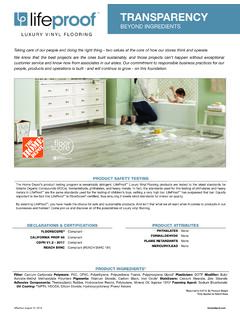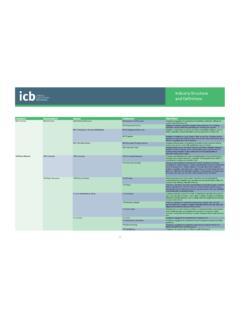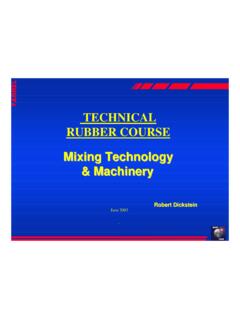Transcription of WOOD FLOORING INSTALLATION GUIDELINES
1 WOOD FLOORING INSTALLATION GUIDELINESR evised 2019 NATIONAL WOOD FLOORING ASSOCIATION TECHNICAL PUBLICATION 2019 NATIONAL WOOD FLOORING ASSOCIATIONWOOD FLOORINGINSTALLATION GUIDELINES 87 SUBSTRATES: Radiant Heat 102 SUBSTRATES: Existing FLOORING 106 UNDERLAYMENTS: Moisture Control 110 UNDERLAYMENTS: Sound Control/Acoustical 116 LAYOUT Working Lines Trammel Points Transferring Lines 45 Angles Wall-Layout Center-Layout Lasers 121 INSTALLATION METHODS: Nail-Down 132 INSTALLATION METHODS: Glue-Down 140 INSTALLATION METHODS: Floating 145 INSTALLATION METHODS: Parquet 150 PROTECTION, CARE AND MAINTENANCE Educating the Customer Protection Care Maintenance What Not to Use 153 REPAIRS/REPLACEMENT/ REMOVAL Repair Replacement Floating Floor Board Replacement Lace-Out/Lace-In Addressing Water Damage 161 GLOSSARY 176 SOURCES/CREDITS 1 INTRODUCTION 2 HEALTH AND SAFETY Personal Protective Equipment Fire and Extinguisher Safety Electrical Safety Tool Safety Industry Regulations 11 INSTALLATION TOOLS Hand Tools Power Tools Pneumatic Tools Blades and Bits 19 WOOD FLOORING PRODUCT Wood FLOORING Options Trim and Mouldings Packaging Conversions and Calculations 27 INVOLVED PARTIES 29 JOBSITE CONDITIONS Exterior Climate Considerations Exterior Conditions of the Building Building Thermal Envelope Interior Conditions 33 ACCLIMATION/CONDITIONING Solid Wood FLOORING Engineered Wood FLOORING Parquet and End-Grain Wood FLOORING Reclaimed Wood FLOORING 38 MOISTURE TESTING Temperature/Relative Humidity Moisture Testing
2 Wood Moisture Testing Wood Subfloors Moisture Testing Concrete Subfloors 45 BASEMENTS/CRAWLSPACES 48 SUBSTRATES: Wood Subfloors 61 SUBSTRATES: Concrete Subfloors 76 SUBSTRATES: Wood Subfloor Systems Over Concrete 81 SUBSTRATES: Screeds/SleepersNATIONAL WOOD FLOORING ASSOCIATION TECHNICAL PUBLICATION 2019 NATIONAL WOOD FLOORING ASSOCIATIONThe National Wood FLOORING Association assumes no responsibility and accepts no liability for the principles or techniques contained in these GUIDELINES /methods. These GUIDELINES and methods for the INSTALLATION of wood FLOORING were developed by the NWFA Technical Publications Committee, together with leading industry authorities, through review of longstanding INSTALLATION principles, along with research and data regarding wood FLOORING INSTALLATION . These GUIDELINES and methods address a variety of ancillary products and components related to the INSTALLATION of wood FLOORING , but are not intended to address issues arising to or from those components every effort has been made to produce accurate and generally accepted GUIDELINES , the principles and practices described in this publication are not universal requirements and may change.
3 The recommendations in these GUIDELINES /methods are directed at the North American market in general, and therefore may not necessarily reflect the most-accepted industry practices in other geographic areas. Some INSTALLATION methods and materials may not be suitable in some geographic areas because of local trade practices, climatic conditions, or construction methods. All wood FLOORING installations must conform to local building codes, ordinances, HOA CC&Rs (Covenants, Conditions and Restrictions), trade practices, and climatic addition, manufacturers recommendations for INSTALLATION of specific products should always supersede the recommendations contained in these is recommended that all wood FLOORING products be installed in accordance with the NWFA INSTALLATION GUIDELINES and all applicable manufacturer instructions by an NWFACP Certified Installer, NWFA member, or equivalent. Copyright 2019. National Wood FLOORING Association. St. Louis, Missouri, All rights reserved under both international and Pan American copyright WOOD FLOORING ASSOCIATION TECHNICAL PUBLICATION 2019 NATIONAL WOOD FLOORING ASSOCIATION1 INTRODUCTIONH ands-on and Online Education Available through NWFA UniversityThe National Wood FLOORING Association offers online and hands-on training courses for wood FLOORING professionals through NWFA University.
4 There is a comprehensive selection of technical education for professionals at all skill levels: Basic, Intermediate, Advanced, Craftsman, and Master Craftsman. For more information, contact NWFA at:[P] [W] of the many benefits of wood FLOORING is that, when installed and maintained properly, they are the only FLOORING option that can last for hundreds of years. In fact, there are documented wood floors in Europe that date back more than five centuries. Wood FLOORING can be maintained and restored to its original appeal after decades of wear and the finest carpets will wear out after only a few years of traffic. Tile and stone can crack or chip when something gets dropped on them, and grout can crack and stain over time. Plastic and vinyl FLOORING can suffocate the home, and are generally designed to be disposable. Those who work with wood floors for a living know that installing them is not a DIY job. You have to have the right tools, the right subfloor, the right jobsite conditions, and the right skills to have a successful INSTALLATION .
5 Wood FLOORING professionals who receive the proper training, and have the necessary industry knowledge, will be well-prepared for nearly any job they FLOORING is available in a wide range of options, including species, widths, thicknesses, shapes and sizes, and even different levels of hardness and dimensional stabilities. Each of these options necessitate an understanding and careful consideration for proper INSTALLATION of the products. There are a number of processes that must be correctly undertaken in order to achieve a floor with the performance and appearance that is of professional standards. These GUIDELINES outline the industry-accepted methods and procedures for wood FLOORING installations. The information included has been organized in a way that will contribute to a successful INSTALLATION . NATIONAL WOOD FLOORING ASSOCIATION TECHNICAL PUBLICATION 2019 NATIONAL WOOD FLOORING ASSOCIATION2injuries alone cost more than $300 million per year in lost production time, medical expenses, and worker compensation.
6 OSHA requires employers to ensure the safety of all employees in the work environment. Eye protection must be provided whenever necessary to protect against chemical, environmental, radiological, or mechanical irritants and hazards. Good eye protection is meant to: Provide adequate protection against the particular hazards for which they are designed. Be of safe design and construction for the work to be performed. Be reasonably comfortable when worn under the designated conditions. Fit snugly and not unduly interfere with the movements of the wearer. Be durable. Be capable of being disinfected and easily cleanable. Be distinctly marked to facilitate identification of the addition: Workers who wear prescription eye glasses must also wear required eye protection. Eye protection often fits comfortably over glasses. Safety goggles and safety glasses may incorporate prescription lenses as well. Dust and chemicals present additional hazards to contact wearers.
7 OSHA recommends that workers have an extra pair of contacts or eyeglasses in case of failure or loss. Ear ProtectionUse of ear protection is very important due to the high decibel of many of the tools used in the wood FLOORING industry. Each hearing protection device has a noise reduction rating (NRR). The higher the number, the greater the decibel reduction. Which type of hearing protection you choose depends on a number of factors including level of noise, comfort, and suitability of the hearing protector. Most importantly, the hearing protector should provide the desired noise reduction. According to OSHA, people should wear a hearing protector if the noise or sound level at the workplace exceeds 85 decibels (A-weighted) or dBA. The Occupational Safety and Health Administration (OSHA) administers rules that aim to protect the safety of workers on the jobsite. These rules may vary according to whether the job is residential or commercial, and requirements are also different for homeowners and professionals.
8 Check OSHA requirements in your area at PART IPersonal Protective EquipmentPersonal protective equipment (PPE) is essential to keeping you safe on the wood FLOORING jobsite. There are six main types of personal protective equipment designed for wood FLOORING professionals:Eye ProtectionThousands of people are blinded each year from work-related eye injuries that could have been prevented with the proper selection and use of eye protection. Eye Before starting any INSTALLATION job, certain basic standards of safety must be applied. It is important that all crew members are briefed and updated on all requirements and regulations. This is important for the safety of you, the crew, the customer, and the jobsite. Before considering going out to install a wood floor, it is imperative to be aware of the safety issues involved. Besides being a vital health issue, following safety regulations is also required by law. Failure to comply can cost you thousands of dollars in AND SAFETYNATIONAL WOOD FLOORING ASSOCIATION TECHNICAL PUBLICATION 2019 NATIONAL WOOD FLOORING ASSOCIATION3the amount of contaminants in the air.
9 Check with the manufacturer of the filter or cartridge for proper storage and service life Full-Facepiece Elastomeric Respirators: Like the half-mask elastomeric respirator, this respirator is a tight-fitting, air-purifying respirator with replaceable filters or cartridges attached to a rubber or silicone facepiece. It needs to be fit tested. The useful service life of the filter or cartridges is how long it provides adequate protection from harmful chemicals in the air. The service life of a filter or cartridge depends upon many factors including environmental conditions, breathing rate, cartridge filtering capacity, and the amount of contaminants in the air. Check with the manufacturer of the filter or cartridge for proper storage and service life recommendations. Knee ProtectionIt is extremely important to protect your knees when doing any type of wood FLOORING work. When installing or finishing wood floors, you spend a lot of time on your knees. This position forces your body weight to the joints of your knees as well as the added weight of the equipment.
10 Knee pads are the solution to preventing occupational knee injuries. Unprotected, sore knees force overcompensation in order to use your knees less. This means that you are transferring the weight that would have been on your knees to your lower back. The result is a sore back and sore knees. Be sure to use knees pads that are comfortable and protect your knees from injury. Avoid knee pads with a hard surface that may mar the FLOORING surface. There are many different types of knee pads available. The function of all knee pads is the same: to prevent knee injury and to protect your knees on the gloves are used to protect the skin from chemical exposure. They are made of different polymers including latex, nitrile rubber, vinyl, and neoprene. Protective gloves should be used when handling adhesives, sealers or solvents of any type. Check with your manufacturer for Ear protection for wood FLOORING professionals generally comes in two types:A. Ear Muffs: Ear muffs consist of sound- attenuating material and soft ear cushions that fit around the ear and hard outer cups.



